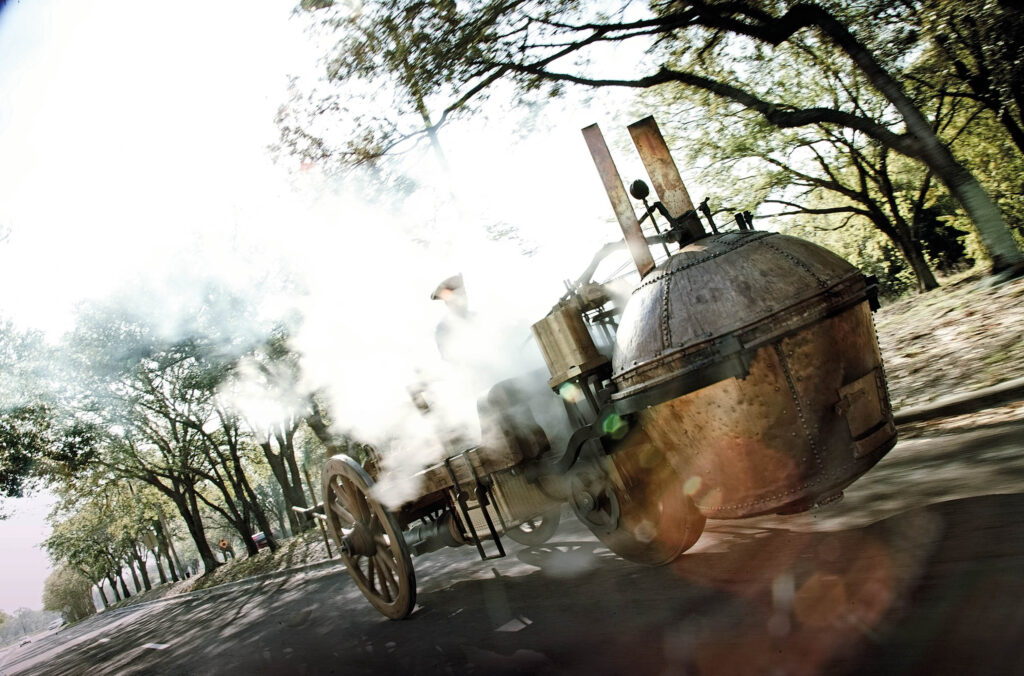We were saddened to hear the news of Alain Cerf’s passing. To pay tribute to the founder of the Tampa Bay Automobile Museum, we have published this feature on his amazing Cugnot replica, which originally appeared in issue 97 of Octane.
Cars screech to a halt, bystanders step back, parents pull children to safety. A bizarre but strangely familiar contraption belches steam and smoke, bellowing deeply on every stroke, creeping slowly but dramatically along the leafy public road.
France, 1770. Nicholas-Joseph Cugnot demonstrates the first ever self-propelled vehicle to the French Army, in a world that relies on animals for transport. If, 241 years on, Cugnot’s invention causes trepidation in a world familiar with 200mph cars, supersonic flight and space travel, its arrival in 1770 must have seemed like the work of the devil himself.
An engraving from the 19th century famously shows Cugnot’s fardier à vapeur crashing into a wall, apparently out of control as men leap away in terror. Cugnot became known not as the creator of the first self-propelled vehicle but as the man responsible for the first ever road accident involving a self-propelled vehicle. His fardier, in ignorant hindsight, was deemed dangerously unstable, vibration-prone, insufficiently braked and inefficiently designed. That view has held sway ever since.

And so back to the present day. We’re at the Tampa Bay Automobile Museum in Florida, where Frenchman Alain Cerf has created a public museum to display his private collection of classic cars, bought with the profits of Polypack Inc, the manufacturing company that shares the museum building.
Alain is an accomplished mechanical engineer, and his cars demonstrate his love of engineering innovation, with special focus on front-wheel drive. He celebrates the lives of often-overlooked engineers such as Voisin and Grégoire – and now Cugnot.
Eight years ago, on a return to his beloved Paris, Alain paid a visit to the Conservatoire National des Arts et Métiers (museum of arts and crafts), where Cugnot’s fardier à vapeur (or ‘steam dray’) has been housed since the French Army donated it in 1801. Looking over it simply to pay his respects to the first ever front-wheel-drive vehicle, Alain couldn’t understand some aspects of the design, and found that the resident experts were unable to help. The exhibit included two films. One attempted to explain the operation of the distributor (which routes steam between the two cylinders using a clever four-way valve) but without accounting for the presence of a leaf spring in the mechanism.

It worked, of that there is no doubt – at least until that now-famous accident


The other showed a black-and-white movie of a fardier in action. The Conservatorie’s fardier is deemed an historical monument and has never been moved, so this one was clearly a replica. Alain tracked it down to the Deutsche Bahn Museum in Nuremberg, and found that it was built specifically for the film, made in 1935 in Germany to celebrate the achievements of the engineers who made steam travel possible. Unfortunately, then-chancellor Hitler banned the film when it became clear that many of those engineers were either English or French.
Nonetheless, Alain eventually offered to modify the German museum’s film fardier – which was crudely built and hadn’t been designed actually to operate – to enable it to be run on compressed air. The Germans agreed, and the fardier was shipped to Florida and converted as promised. But don’t assume that’s the fardier you see here – it’s not.
The German replica had merely whetted Alain’s appetite: he was convinced that this version wasn’t as Cugnot had intended, and wanted to find out why. There were aspects of the design that didn’t make sense, and yet much of it had clearly been made to an extremely high standard. So why had Cugnot’s achievements attracted so little attention and acclaim in their day? Alain wanted better to understand Cugnot’s thought processes and, despite lacking any experience of steam engines, decided that the best way to do this would be to build an accurate, working replica.

It’s important at this point to understand that Cugnot was a military engineer, and that the fardier was an army vehicle; it was never intended to have civilian uses, nor was it meant as a showcase for new technology. It was built to carry heavy loads – cannons in particular – that horses wouldn’t have been able to cope with, but it was recognised that it would travel alongside horses and foot soldiers, so its speed was never an issue.
Cugnot had been experimenting wth steam power for several years and, with encouragement from defence minister, the Duke de Choiseul, and reformer General de Gribeauval, he initially built a small version of the fardier. That was in 1769 but it was too small to be of any use. So he improved and enlarged the design, and in 1770 completed the full-size fardier à vapeur.
It was controversial from the start. One army officer, a deadly rival of Gribeauval, said: ‘The mania for novelties begs belief… if the machine was not in one of the arsenal workshops in Paris, where we can see it, we would find it as ingenious as it is useless.’ But it worked, of that there is no doubt, at least until that now-famous accident, which occurred around the end of 1771 or early in 1772.

Progress is smooth and controllable, though it doesn’t last for long before the fardier runs out of steam


And so, mired in politics, the fardier was abandoned in the arsenal for nearly 30 years, virtually unheard of outside of the French Army. In February 1799 it was transferred to the Conservatoire Impérial des Arts et Métiers (as it was called then), and has remained virtually untouched from that point to the present day.
The more Alain examined it, the more he could see how well the majority of the fardier had been built. This wasn’t a rough and ready prototype; it was designed for low-volume production. Cugnot wasn’t the first to harness steam power, but he was the first to use it to propel a vehicle (unless you count a steam-powered toy, possibly built by Ferdinand Verbiest in around 1672). And the simplicity of the ratchet mechanism he used to drive the wheels was pure genius.
The mounting for the heavy boiler was similarly simple yet clever, with the iron frame cantilevered so that none of the fixing bolts takes any weight. This was a machine that could be built relatively quickly and easily with the tools of the day, and was strong enough to survive tough combat situations.

Yet the boiler of the Conservatoire’s fardier today is clearly under-specified, too small, and without any means to top it up with water. The cylinders are uncharacteristically poorly made and there’s no safety valve fitted to the boiler, even though a valve was known to be a necessity even back in 1770. And there are also discrepancies between descriptions and drawings made around 1770, and those made once the fardier was installed in the museum.
Alain was baffled but intrigued. He went back to his research and found a comment from the 18th century relating how looters (after scrap metal) were chased from the arsenal. It seems the bronze cylinders and distributor were stolen and almost certainly remade by the museum many years later.
But what of the clearly inefficient boiler and the apparently redundant leaf spring? Alain suggests that, following the infamous accident, the original – and now damaged – boiler might have been swapped for the smaller experimental boiler from the 1769 fardier, and reassembled incorrectly with the chimneys back to front. It seems feasible, as does his theory that the accident was caused by someone inadvertently operating the regulator lever while the fardier was steaming up.
As for the leaf spring, Alain soon worked that out once he started experimenting. There comes a point at which the four-way valve in the distributor can get stuck, but the leaf spring cleverly prevents this. The mystery was solved!
And so to Alain’s recreation, built using mostly 18th-century methods and materials. The chassis is of oak, the wheels of ash, the ratchet mechanism an exact replica of the Conservatoire fardier’s, and the distributor, cylinders and boiler intelligent estimations of how Cugnot would have designed his.

It was a steep learning curve for Alain and his team but by late 2010 their fardier was complete. It’s an incredible feat of engineering and historical research, and disproves the unflattering reputation that Cugnot’s fardier has acquired.
It needs a good hour to get fired up, burning wood in the boiler to build up steam. Driver and passengers sit up high, utterly exposed, their views largely blocked by the cylinders, distributor and massive boiler – and by the steam that swirls around them.
The driver pulls and pushes a lever to regulate power delivery, and the fardier eases forward with little speed but obvious torque, chuffing loudly and rocking slightly. This machine could pull a forest from the ground, albeit slowly. The noise is considerable, the heat and humidity from the boiler significant but not searing, and the assault on the senses leaves all involved feeling vulnerable and open to the elements.

To steer, the long cranked bar in front of the centrally placed driver must be whirled around at some speed, but it’s light enough to cope with, and the fardier responds easily enough. Braking, thought to be laughable when it was assumed from the incomplete Conservatoire fardier that it relied upon a claw catching into grooves in the iron wheel rim, is actually slightly better – nervous-giggle-inducing rather than actually laughable, perhaps – now that Alain has discovered that the claw was intended to hold a wooden brake pad.
But, most interestingly, progress is smooth and controllable, though it doesn’t last for long before the fardier runs out of steam and has to stop for a while to recover. Alain’s boiler design hasn’t yet reached the reported performance of the more experienced Cugnot’s efforts, but he’s working on improvements.
Amusingly, the Tampa Bay fardier is road-registered (ah, those easy-going Floridians!) and we trundle along the road outside the museum to a flurry of screeching tyres as wide-eyed road users brake hard to whip out their camera phones. They don’t necessarily understand what they’re seeing but we know for sure – it’s the vindication of one of the all-time greats of engineering.
Cugnot fardier à vapeur replica specifications
Engine Steam-powered, two cylinders, four-way distribution valve, wood-fired tubular boiler
Power 12bhp approx
Transmission Front-wheel drive via reversible ratchet mechanism, to allow forward and reverse
Steering Rack and pinion
Suspension Reliant on the flex of the oak chassis
Brakes Hand lever operating a wooden block on the front wheelrim
Weight 2500kg
Top speed 2.5mph
Thanks to the Tampa Bay Automobile Museum, Florida, www.tbauto.org. Alain Serf has written a book on Cugnot and the fardier, available from the museum.




